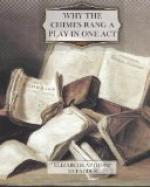If the fire-place cannot be made, then a charcoal brazier will serve as an excuse for light and give a sense of warmth to the scene. The brazier can easily be made by any tinsmith from a piece of sheet iron supported on three legs, and there is an illustration of it in the right hand corner of the accompanying scenery plate.—An electric torch or even an ordinary lantern can be slipped inside the little stove to give out a faint glow. A piece of one of the amber screens put over the torch or lantern will warm the light and the brazier can be placed anywhere in the hut.
The chancel may be lighted by a number of incandescent bulbs hidden at the sides of the scene, with the light so shielded that it shines on the altar and not into the hut. An especially effective place to put a strong light is inside the box representing the altar, with a hole cut in the top of the box so that the light shines up, giving a central radiance to the appointments of the altar and throwing into prominence the face and costume of each person who approaches it. If any of this light seems glaring it can be softened and diffused by masking it with amber or straw colored cheesecloth.
Some form of search light is practically a necessity for producing the heavenly radiance that shines upon the angel. If procurable, a “baby spot light” is the best appliance, but lacking this, an automobile lamp and its battery can be used.
It is important that all light in the hut should go out when the vision of the chancel appears so that the hut becomes merely an inner proscenium or dark frame around the rich picture of the altar. This of course does not mean that the lantern in the brazier need be extinguished as the light given by that is negligible.
After the angel ceases speaking the tableau of the altar scene should be held as the music grows louder and louder through the final crescendo; then, when the final note has been sung, blot out the stage by extinguishing all lights. Give a moment of darkness during which the back wall of the hut is replaced, and the old woman slips out of the nearest opening in the scenery. Then turn on the front lights which illuminated the hut during the first part of the play.
MUSIC.
The three pieces of music required for this play are as follows:
“The Sleep of the Child Jesus” part song for mixed voices by F.A. Gevaert.
Eightfold Alleluia composed for “Why the Chimes rang” by Percy Lee Atherton.
These two pieces come published together in a special edition for use with this play by The Boston Music Company. Price 15 cents per copy, postpaid.
The bell movement (in five flats) (Postlude) by J. Guy Ropartz. Published by The Boston Music Company. Price 30 cents per copy, postpaid.
For all the music, address The Boston Music Company, 116 Boylston Street, Boston, Mass.




